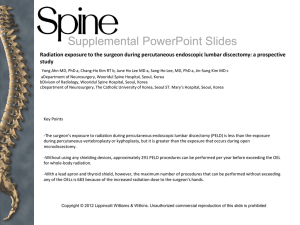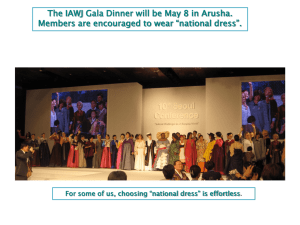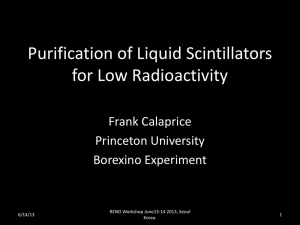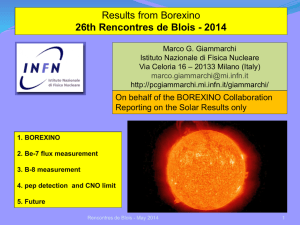F. Calaprice
advertisement
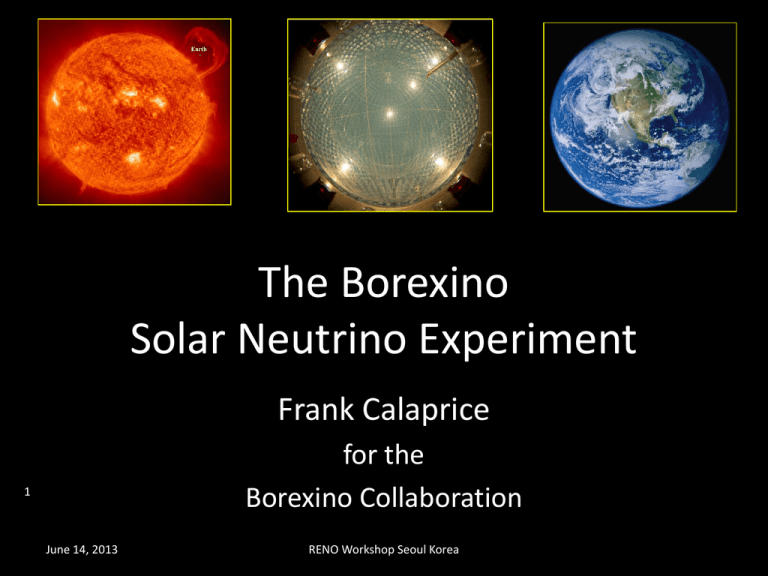
1 The Borexino Solar Neutrino Experiment Frank Calaprice for the Borexino Collaboration 1 June 14, 2013 RENO Workshop Seoul Korea Borexino Collaboration Princeton University Genova Milano APC Paris Virginia Tech. University Perugia Univ. Massachusetts Dubna JINR Kurchatov Institute Jagiellonian U. Cracow MPI Heidelberg June 14, 2013 RENO Workshop Seoul Korea Tech. Univ. Munich 2 The Borexino Detector (Mostly Active Shielding) • Shielding Against Ext. Backgnd. – Water: 2.25m – Buffer zones: 2.5 m – Outer scintillator zone: 1.25 m • Main backgrounds: in Liq. Scint. – 14C/12C • 10-18 g/g. cf. 10-11 g/g in air CO2 – U, Th impurities • Dirt • Needed: • Obtained: 10-6 g/g 10-16 g/g 10-18 g/g – Radon daughters (210Pb, 210Bi, 210Po) • Light yield (2200 PMT’s) – Emitted: – Detected: 11,000 photons/Mev 500 pe/MeV (~4%) • Pulse shape discrimination. – Alpha-beta particle separation June 14, 2013 RENO Workshop Seoul Korea 3 Solar Nuclear Fusion Cycles The pp cycle June 14, 2013 The CNO cycle RENO Workshop Seoul Korea 4 Historical Note • Chlorine experiment: – First solar neutrino detector was the chlorine radiological experiment. – Technique avoids the intense source of radiological backgrounds by producing 37Ar by the reaction 37Cl(n,e)37Ar. • Gallium radiochemical experiment – Used simliar technique to measure pp neutrinos • Kamiokande, Super-K, and SNO – Detected high enegy 8B neutrinos (> 5 MeV ) to avoid radiological backgrounds • Borexino – First experiment to directly detect neutrinos in the midst of soup of radiological background @ E < 3 MeV. – Made possible by development of new low-background methods. – I like to call it a major breakthrough in experimental physics. June 14, 2013 RENO Workshop Seoul Korea 5 Neutrino Detection June 14, 2013 RENO Workshop Seoul Korea 6 Solar Neutrino Spectra Neutrino Energy Spectrum p.e.) 10 x tons 100 x (day / Events 103 102 10 1 10-1 10-2 10-3 Total spectrum 8 n( B) = 0.46 cpd/100 tons 862 n(7 Be) = 47.6 cpd/100 tons n(CNO) = 5.36 cpd/100 tons n(pep) = 2.8 cpd/100 tons n(pp) = 133 cpd/100 tons 100 200 300 400 500 600 700 800 900 1000 Photoelectrons 7 RENO Workshop Seoul Korea June 14, 2013 Neutrino-Electron Elastic Scattering Energy Spectrum Borexino Measurements 2007-2012 Solar Neutrinos ✓7Be 46.0 ✓ 8B (> 3 MeV) 0.22 ✓ Pep 3.1 ✓ CNO limit < 7.9 ✓7Be day/night asy. ✓7Be annual mod. cpd/100t ± 5%. cpd/100t ± 19% cpd/100t ± 22% cpd/100t A = 0.001 ± 0.014 PRL PRD PRL PRL PLB PLB 2011 2010 2012 2012 2012 2012 PLB 2013 PRC PRD 2010 2012 Geo-neutrinos Geo-neutrinos 14.3 ± 3.4 eV/(613 t-yr) Rare Processes Test of Pauli Exclusion Principle in Nuclei Solar axion upper limit June 14, 2013 RENO Workshop Seoul Korea 8 June 14, 2013 RENO Workshop Seoul Korea 9 General Comments Backgrounds • Long-lived Cosmogenic: – – • in hydrocarbon liq. Scint. Use material from deep site • • • Active shielding Detector materials • • Self shielding Scintillation Pulse shape Discrimination rejects a’s in scintillator Radon daughters background. 210Bi, 210Po are serious June 14, 2013 ~ 7% @ 1 MeV Event position determination – – • • 11,000 photons/ MeV 500 pe/MeV with 28% QE PMTs Energy resolution – • 2200 8“ PMTs with concentrators. Coverage: ~ 34% Light yield: – – • Pseudocumene + 2.5 g/l DMP Scintillation light is quenched. Photomultipliers: – – Rock (room background) • – 222Rn, 210Pb. 210Bi, Pseudicumene + 1.5 g/l PPO Buffer zones – – Need deep site & active shielding. Radiogenic (U, Th, K, 210Po) – • – 14C Short-lived Cosmogenic – • Specifications. • Liquid scintillator photon time-of-flight. Resolution: ~12 cm @ 1 MeV Muon flux: 1.1 mu/m2/hr. Alphs/beta separation: pulse shape RENO Workshop Seoul Korea 10 2011 spectrum 7Be with 210Po a’s 210Po 210Bi 85Kr CNO June 14, 2013 RENO Workshop Seoul Korea 11 7Be: fit of the energy spectrum R 46 ± 1.5 ( stat ) 11..65 ( syst ) cpd / 100t Rno oscillation 74± 5.2 cpd / 100t 5 s evidence of oscillation ne flux reduction 0.62 +- 0.05 electron neutrino survival probability 0.51 +- 0.07 •Search for a day night effect: •not expected for 7Be in the LMA-MSW model •Large effect expected in the “LOW” solution (excluded by solar exp+Kamland) ADN N D 0.001± 0.012 ( stat) ± 0.007( sys) ( N D) / 2 G. Bellini et al., Borexino Collaboration, Phys. Lett. B707 (2012) 22. June 14, 2013 RENO Workshop Seoul Korea 12 The first pep n measurement : multivariate analysis and background subtraction Expected pep interaction rate: 2-3 cpd/100t Background: 11C 210Bi external g 210Bi and CNO spectra: very similar 11C 210Bi G. Bellini et al., Borexino Collaboration, Phys. Rev. Lett. 108 (2012) 051302.. pep CNO Three Fold Coincidence: 11C reduction Novel pulse shape discrimination: e+ from 11C decay form Positronium live time before annihilation in liquid: few ns delayed scintillation signal (Phys. Rev. C 015522 (2011)) Multivariate analysis: fit of the energy spectra fit the radial distribution of the events ( external background is not uniform) June 14, 2013 RENO Workshop Seoul Korea fit the pulse shape parameter 13 Physics implication of the solar n Borexino results: the Neutrino Survival Probability Pee(E) Confirms MSW Vacuum to Matter Enhanced Oscillations Before the Borexino results G. Bellini et al., Borexino Collaboration, Phys. Rev. Lett. 108 (2012) 051302.. First solar pep neutrino detection G. Bellini et al., Borexino Collaboration, Phys. Rev. Lett. 107 (2011) 141362. High precision 7Be solar neutrino measurement Combined analysis Borexino&solar G. Bellini et al., Borexino Collaboration, Phys. Rev. D82 (2010) 033006. 8B flux with a threshold of 3MeV (e- recoil) June 14, 2013 RENO Workshop Seoul Korea 14 Terrestrial and Reactor Neutrinos • Terrestrial neutrinos are produced by long-lived radioactive elements, U, Th, K. – Energy is confined to < 3 MeV – Radioactive decay accounts for significant part of known heat produced inside earth • Reactor neutrinos are produced by the decay of fission fragments in nuclear reactors. – Energies of reactor neutrinos are higher than geoneutrinos, but they can be an important background. – No nuclear power reactors in Italy; background is small. • Both neutrinos are seen together at low comparable rate. June 14, 2013 RENO Workshop Seoul Korea 15 geon results: evidence of the signal Others back. Ngeo Nreactor Ngeo Nreactor measured measured measured measured Events events events events TNU TNU 60.4±2.4 0.70±0.18 14.3±4.4 31.2-6.1+7 38.8±12.0 84.5+19.3-16.9 Nreactor Nreactor Expected with osc. Expected no osc. events 33.3±2.4 Unbinned likelihood fit No geon signal: rejected at 4.5 s C.L. geon reactor June 14, 2013 RENO Workshop Seoul Korea 16 geon results: U and Th separation Chondritic U-Th ratio Fit with weight of 238U and 232Th spectra free June 14, 2013 RENO Workshop Seoul Korea Best fit S(238 U)= 26.5 ± 19.5 TNU S(232 T) = 10.6 ± 12.7 TNU 17 Borexino Phase 2 Solar Neutrino Program • Technical goals: – Reduce scintillator backgrounds with loop purification • • 210Bi (210Pb) 85Kr by nitrogen stripping • Measurement goals – pp neutrino observation – CNO neutrinos detection or lower limit – Improve pep, 7Be, 8B measurement June 14, 2013 RENO Workshop Seoul Korea 18 Phase-2 Borexino Program Scientific Goals • The Metallicity Problem: – Measurement of CNO neutrinos will shed light on the controversial abundance of heavy elements. • Sterile Neutrinos: – The “SOX” Source Experiment will place a 10 MCi 51Cr source under Borexino to search for short baseline beutrino oscillations. • Motivated by reactor, gallium, and Miniboone neutrino anamolies June 14, 2013 RENO Workshop Seoul Korea 19 The Solar Metallicity Problem • In 1998 the metallicity (abundance of elements heavier than 4He) determined from line spectra in Sun’s atmosphere agreed well with other data. – Standard solar model based on uniform composition. – Helioseismology data – Solar neutrino data (8B by SNO) • Improvements were made in the analysis of solar atmospheric spectra over next 10 years (3D model,etc.) – A 2009 assessment of data resulted in a lower metallicity. • Z /X = metal/hydrogen ratio = 0.024 (GS98) 0.018 (AGSS09). – The new resukts are in conflict with helioseismic data that probe the composition at greater depths in the sun. • This is a serious problem for stellar models because it implies that the chemical composition is not uniform. June 14, 2013 RENO Workshop Seoul Korea 20 Re-Purification of the Liquid Scintillator for Lower Background • Reducing backgrounds is essential for Phase 2 solar program. – 210Bi obscures CNO and pep neutrinos. – 85Kr interferes with 7Be neutrinos • Purification of the scintillator by “water extraction” and “nitrogen stripping” was carried out recently. – Backgrounds were reduced significantly. – Lower background is still necessary. • Refinements in water extraction are being developed. • Discussion of purification in my next talk. June 14, 2013 RENO Workshop Seoul Korea 21 Lower Backgrounds after Recent Scintillator Purification by Water Extraction and N2 Stripping Before Re-purification of L.S. 85Kr June 14, 2013 210Bi = 38 ± 2.9 cpd/100t After Re-purification: = 28 ± 5 cpd/100t RENO Workshop Seoul Korea 210Bi = 21 ± 4 cpd/100t 85Kr < 5 cpd/100t 22 Short distance ne Oscillations with Borexino (SOX) June 14, 2013 RENO Workshop Seoul Korea 23 SOX Expected Sensitivity (51Cr) June 14, 2013 RENO Workshop Seoul Korea 24 June 14, 2013 RENO Workshop Seoul Korea 25 Conclusions • Borexino was started in the early 90’s to determine if the low energy 7Be solar neutrinos exhibit neutrino oscillations. • Twenty years later, the evidence for oscillations with the peculiar energy dependence in matter predicted in MSW theory is convincing. • The new data were made possible with innovations in low background methods that are relevant for new rare event challenges: – Direct detection of dark matter WIMPS – Neutrinoless double beta decay June 14, 2013 RENO Workshop Seoul Korea 26
